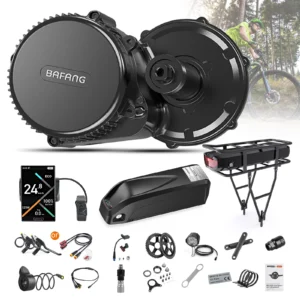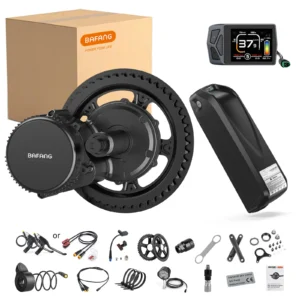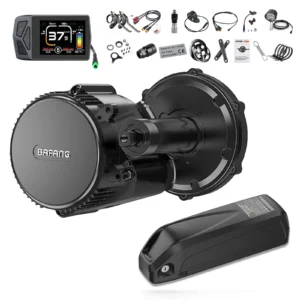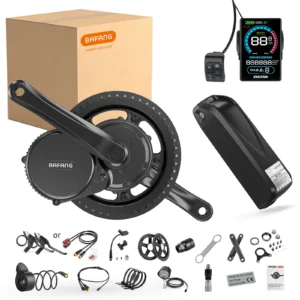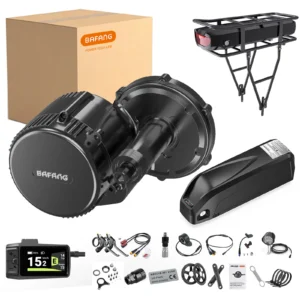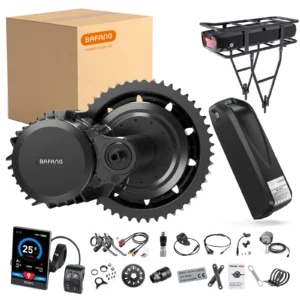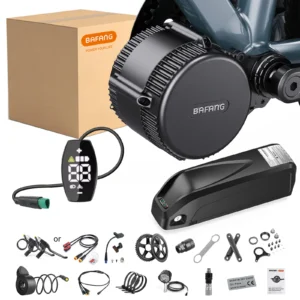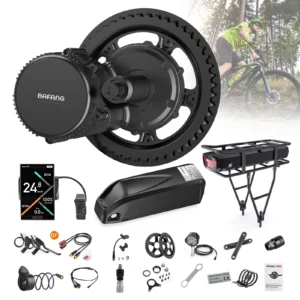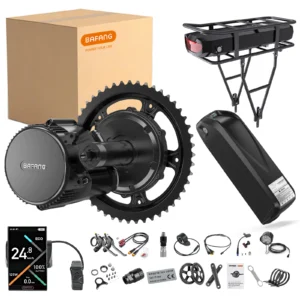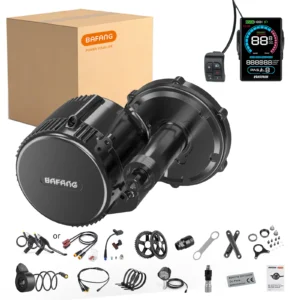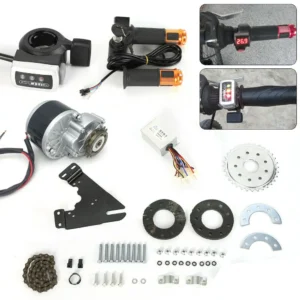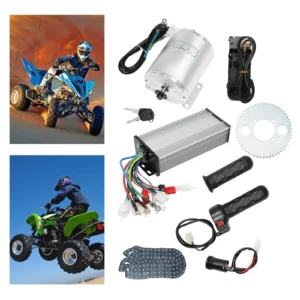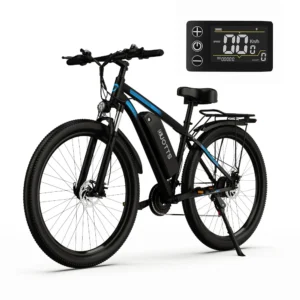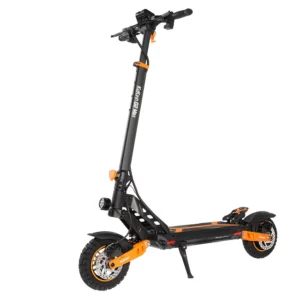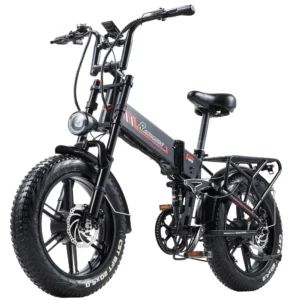Summa: 203,80 €
Elektriskās pārveidošanas komplekti
Rāda 126–143 no 143 rezultātiemKārtots pēc popularitātes
Elektriskās pārveidošanas komplekti piedāvā aizraujošu un bieži vien rentablu veidu, kā elektrificēt jūsu esošo velosipēdu, pārveidojot ierastu braucamo par jūsu vēlmēm pielāgotu elektrisko velosipēdu ar motoru. Tā vietā, lai iegādātos pilnīgi jaunu elektrisko velosipēdu, šie komplekti nodrošina nepieciešamās sastāvdaļas – motoru, akumulatoru, kontrolieri un displeju/droseli –, kas ļauj jums uzlabot jau esošu un iecienītu velosipēdu. Šī pieeja ir piemērota "dari pats" entuziastiem, budžeta apzinīgiem riteņbraucējiem un tiem, kam ir konkrēts velosipēda rāmis, ko viņi vēlas saglabāt, vienlaikus izmantojot elektriskās palīdzības priekšrocības. Šī rokasgrāmata palīdzēs jums orientēties elektrisko velosipēdu pārveidošanas komplektu pasaulē un saprast, kā izvēlēties pareizo savam projektam.
E-velosipēdu pārveidošanas komplektu veidi: rumbas un vidējās piedziņas komplekts un galvenie apsvērumi
Iedziļinoties elektrisko velosipēdu pārveidošanas komplektu veidi, būtiskākā atšķirība ir starp rumbas motoru komplekti un vidējās piedziņas motoru komplekti. Rumbas motoru komplekti integrējiet motoru priekšējā vai aizmugurējā riteņa rumbā. Priekšējā rumbas motorus parasti ir vienkāršāk uzstādīt, un tie var piedāvāt labu pilnpiedziņas sajūtu, savukārt aizmugurējā rumbas motori nodrošina labāku saķeri un tradicionālāku velosipēda sajūtu, taču tie var būt sarežģītāki ar pārslēdzēju un kasešu saderību. Rumbas motori bieži vien ir lētāki un var būt laba izvēle līdzenākam reljefam vai vienkāršākai pārveidošanai. Vidējas piedziņas motoru komplekti, no otras puses, nomainiet velosipēda esošo kloķvārpstu un apakšējo gultni. To galvenā priekšrocība ir tā, ka tie izmanto jūsu velosipēda esošos pārnesumus, nodrošinot lielisku griezes momentu kalnā kāpšanai un dabiskāku pedāļu mīšanas sajūtu. Tomēr komplekti ar vidējas piedziņas pārnesumiem parasti ir dārgāki un to uzstādīšanas process ir sarežģītāks. Galvenie apsvērumi, izvēloties, ir velosipēda paredzētais lietojums (kalnā vai līdzenumā), jūsu mehāniskās spējas uzstādīšanai un jūsu budžets.
Komplekta saskaņošana: akumulatora, kontroliera un svarīgo velosipēdu saderība
Veiksmīgi pielāgojot pārveidošanas komplekta komponentus, īpaši akumulatoru un kontrolieri, un nodrošinot kritiski svarīgu velosipēda saderību ir ārkārtīgi svarīgi veiksmīgai būvniecībai. akumulators ir izšķiroša izvēle: tā spriegumam (piemēram, 36 V, 48 V, 52 V) ir jāatbilst motora un kontrollera specifikācijām. Jauda, kas mērīta ampērstundās (Ah) vai vatstundās (Wh), noteiks jūsu nobraukumu — līdzsvarojiet vēlamo nobraukumu ar akumulatora svaru un fizisko izmēru. Apsveriet montāžas iespējas: izplatītākās izvēles iespējas ir apakšējā caurule (stiprinājumi pie pudeļu turētāja), aizmugurējais bagāžnieks vai pat rāmja somas. kontrolieris ir sistēmas smadzenes, kas regulē jaudu no akumulatora uz motoru; tai jābūt saderīgai ar abiem. Meklējiet tādas funkcijas kā pedāļu palīgsistēmas līmeņi un droseles opcijas. Kritiskā velosipēdu saderība Nevar pārspīlēt: pārliecinieties, vai jūsu velosipēda rāmis (materiāls un dizains — oglekļa šķiedras rāmji bieži vien nav ieteicami) var izturēt papildu slodzi un svaru. Rumbas motoriem pārbaudiet velosipēda izciļņa atstarpi. Vidējās piedziņas motoriem pārbaudiet apakšējās ass veidu un izmērus. Apsveriet arī bremžu saderību, jo daži komplekti var traucēt noteiktiem bremžu tipiem.
Kāpēc pārveidot velosipēdu? Ieguvumi, uzstādīšana un likumība
Lēmums par Velosipēda pārveidošana par elektrisko velosipēdu sniedz vairākas priekšrocības, taču ir svarīgi izprast uzstādīšanas realitāti un vietējos likumus. Primārais priekšrocības bieži vien ietver ievērojamus izmaksu ietaupījumus salīdzinājumā ar jauna, salīdzināma e-velosipēda iegādi. Tas ļauj jums paturēt velosipēdu, kuru jau pazīstat un mīlat, iespējams, tādu, kas ir ideāli piemērots vai kam ir sentimentāla vērtība. Pārveidošanas komplekti piedāvā augstu pielāgošanas pakāpi, ļaujot izvēlēties konkrētu motora jaudu, akumulatora ietilpību un funkcijas. Tā ir arī ilgtspējīga izvēle, pārstrādājot esošu velosipēdu. Tomēr uzstādīšanas realitāte tas nozīmē, ka jums būs nepieciešamas pienācīgas mehāniskās prasmes, labs velosipēda instrumentu komplekts (un, iespējams, daži specializēti instrumenti, piemēram, kloķvārpstas novilcēji vai apakšējā kronšteina instrumenti vidējiem pārnesumiem) un pacietība problēmu novēršanai. Laiks, kas nepieciešams, var atšķirties. Visbeidzot, ņemiet vērā vietējie likumi par e-velosipēdiem attiecībā uz maksimālo jaudu, ātruma ierobežojumiem un to, vai pārveidoti velosipēdi tiek apstrādāti citādi nekā rūpnīcā ražoti elektriskie velosipēdi. Mūsu veikalā mēs piedāvājam plašu elektriskās pārveidošanas komplektu klāstu, kā arī pilnīgus elektriskos velosipēdus, elektriskos skrejriteņus un dažādus akumulatoru risinājumus, un mūsu komanda var sniegt palīdzību, lai veiksmīgi uzsāktu jūsu elektriskā velosipēda pārveidošanas projektu.

 3000 W 72 V 30 Ah 6600 apgr./min elektriskā skrejriteņa/e-velosipēda bezsuku pārveidošanas komplekts
3000 W 72 V 30 Ah 6600 apgr./min elektriskā skrejriteņa/e-velosipēda bezsuku pārveidošanas komplekts 